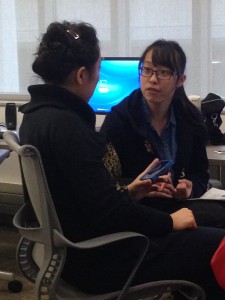In addition to the collection of historic information and data about Sullivant Hall this semester, an ACCAD course taught by Jeremy Patterson has been exploring the ways in which different app designs might support the delivery of a range of collected Sullivant Hall stories to the public in fun and interactive ways. Students developed a variety of interfaces intended to work with hand-held devices and our beacons. This effort helps us imagine possible ways of structuring the project. One of the most exciting aspects of using student’s creative efforts to explore these possibilities is the engagement of students from a variety of courses in user testing sessions with Patterson’s class. Students who submitted information to be considered for the project in their own courses sat side-by-side with the future app designers during class meetings held late in the term. They provided feedback on the clarity, usability, and excitement each app design idea allowed. With valuable input from this broad range of students, the app designers were able to modify and adjust their designs to create even more effective potential experiences for our future users. Now the Seeding Sullivant project will now move forward with web page content development and designs created with the help of two Design MFA students. Patterson’s students’ ideas will give us insight into what might be possible.
Uncategorized
Welcome to the “Seeding Sullivant Hall” project blog

This blog documents the progress of the “Seeding Sullivant Hall” project; a multidisciplinary collaborative effort to research, document and share the many histories of The Ohio State University’s recently renovated Sullivant Hall. This place-based project celebrates the reinvigorated life of Sullivant Hall and its history by embedding the building’s interior environment with beacon technology that enables access to a database of narratives about the building using smart devices. Our goals include providing alternative means of navigating the building that offer virtual experiences of place that put occupants with smart devices in touch with the building’s history in a dynamic way.
Initial funding for this the project has been provided by a One Ohio State Framework Project Grant. Testing technology and associated devices began in Fall, 2014. The project is spear-headed by Professor Maria Palazzi (Department of Design and Director of the Advanced Computing Center for the Arts and Design-ACCAD). In addition, the project team members include Professor Mary Anne Beecher, Ph.D., Department of Design (and blogger); Tamara Chute, OSU University Archives; Adjunct Professor Clayton Funk, Ph.D., Department of Arts Administration, Education and Policy; Matthew Lewis, Ph.D., ACCAD; Professor Susan Petry, Department of Dance; Professor David Staley, Ph.D., Department of History; and Professor Deborah Smith-Shank, Ph.D, Department of Arts Administration, Education and Policy.
A proof-of-concept for the application that is part of this project’s infrastructure is under development now. Further assessment of the opportunities that the beacons afford and the design and development of the app are on the agenda for the next several months. At the same time, students in several undergraduate and graduate level courses in the College of Arts and Sciences will be helping to collect and present visual, verbal, and text-based “stories” about the significance of Joseph Sullivant and the history of Sullivant Hall and its past and current occupants. This information will become the substance of the project. Please stay tuned to see examples of our findings, updates on our progress and please share any memories of Sullivant Hall here so we can consider including them in our project!
